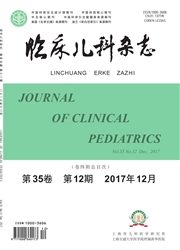

 中文摘要:
中文摘要:
目的:观察死亡受体6(DR6)在缺血缺氧脑损伤(HIBD)新生大鼠皮层的表达及其作用。方法7日龄新生大鼠制成HIBD模型。免疫组化染色观察HIBD后24 h、72 h、7 d DR6以及HIBD后24 h半胱天冬酶(Caspase)-3的表达情况;焦油紫染色评价HIBD后7 d神经元损伤情况;T-迷宫试验评价HIBD后60 d的认知功能。结果 HIBD组皮层DR6表达在HIBD后24 h最显著,72 h、7 d逐渐下降,不同时间点的差异有统计学意义(P〈0.01);HIBD后24 h、72 h,HIBD组DR6表达量均高于对照组,差异有统计学意义(P均〈0.01)。HIBD后24 h,HIBD组皮层Caspase-3阳性细胞高于对照组,差异有统计学意义(P〈0.05)。HIBD后7 d,HIBD组皮层神经元数目低于对照组,差异有统计学意义(P〈0.05)。HIBD后60 d, T-迷宫试验显示HIBD组认知下降,与对照组差异有统计学意义(P〈0.05)。结论 DR6信号通路在未成熟脑神经细胞损伤中起重要作用,可能导致以后认知功能障碍。
 英文摘要:
英文摘要:
Objectives To observe the expression of death receptor 6 (DR6) in neonatal rats with hypoxia-ischemia brain damage (HIBD). Methods HIBD was induced in day 7 rats. The expression of DR6 at 24 h, 72 h and 7 d after HIBD and the expression of Caspase-3 at 24 h were evaluated by immunostaining. The injury of neural cells was evaluated by cresyl violet at 7 d after HIBD. The cognitive function was evaluated by T-maze test at 60 d after HIBD. Results DR6 positive cells were the most abundant in the ipsilateral cortex at 24 h after HIBD, and decreased gradually at 72 h and 7 d after HIBD. There was signiifcant difference of the expression of DR6 among different time points in HIBD group (P〈0.01). Compared with control group, DR6 positive cells were more abundant in the ipsilateral cortex at 24 h and 72 h after HIBD (P〈0.01) and caspase-3 positive cells were more abundant in the ipsilateral cortex at 24 h after HIBD (P〈0.05). The number of cortical neurons were decreased at 7 d after HIBD as compared with control group (P〈0.05). The T-maze test showed there was decline of the cognition in HIBD group com-pared with control group (P〈0.05). Conclusions The DR6 signaling pathway plays an important role in cerebral cortex injury which may lead to the subsequent neurofunctional deifcits in neonatal HIBD rats.
 同期刊论文项目
同期刊论文项目
 同项目期刊论文
同项目期刊论文
 Chondroitin sulfate proteoglycans impede myelination by oligodendrocytes after perinatal white matte
Chondroitin sulfate proteoglycans impede myelination by oligodendrocytes after perinatal white matte 期刊信息
期刊信息
